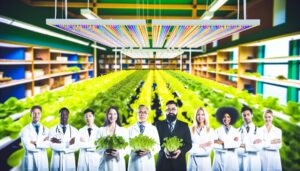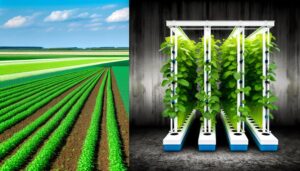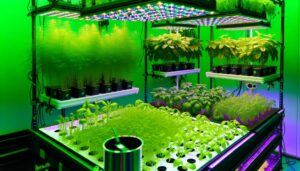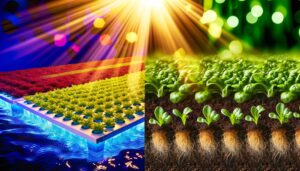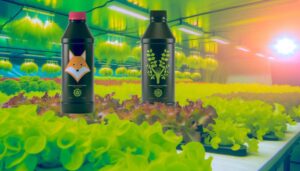Is Hydroponically Grown Food Called a Farm?
Yes, hydroponically grown food is produced on a farm. While it uses water-based systems instead of soil, the USDA recognizes hydroponics as valid farming.
This method is highly efficient, yielding 30% more per acre and using 90% less water compared to traditional farming.
It’s environmentally friendly and supports sustainable agriculture through reduced pesticide use and maximized space utilization via vertical setups.
The legal framework governing hydroponics guarantees its adherence to agricultural norms, making it a legitimate type of farming.
To learn more about its benefits and economic viability, keep exploring further information.

Key Takeaways
Definition of a Farm
A farm, traditionally defined as a tract of land dedicated to agriculture and raising animals, now includes modern methods like hydroponics. You’ll find that hydroponics is a method where plants grow in nutrient-rich water rather than soil. This innovative technique allows farmers to grow crops in controlled environments, optimizing resource use and reducing dependency on fertile land. As more people explore sustainable farming, many ask, what is a hydroponic farm and how does it differ from traditional agriculture? Essentially, a hydroponic farm utilizes water-based nutrient solutions to cultivate plants, often leading to higher yields and faster growth.
This innovative approach expands the definition of farming beyond traditional land use.
According to USDA data, hydroponic farms can produce up to 30% more yield per acre compared to soil-based farming. Hydroponics also uses 90% less water, aligning with sustainable practices.
Traditional Farming Methods
Traditional farming methods involve cultivating crops and raising livestock on soil-based land, utilizing practices that date back centuries and form the backbone of modern agriculture.
You’ll find that these methods rely heavily on the natural environment sunlight, rainfall, and soil nutrients.
Techniques like crop rotation, polyculture, and organic fertilization are employed to maintain soil fertility and manage pests.
Data shows that traditional farming contributes approximately 80% of the world’s food supply. Yet, these methods can be resource-intensive, consuming large amounts of water and land.
Mechanized equipment and synthetic inputs have increased productivity but often at the cost of environmental sustainability.
Understanding these methods provides a baseline to compare newer techniques like hydroponics, which seek to optimize resource use and enhance food production efficiency.
Basics of Hydroponics
While traditional farming methods have their merits, hydroponics offers a soil-free alternative that maximizes efficiency by using nutrient-rich water solutions to cultivate plants.
This technique allows you to control variables like pH levels, nutrient concentration, and water temperature, resulting in faster growth rates and higher yields.
Key benefits include:
- Water Efficiency: Hydroponics uses up to 90% less water compared to soil farming.
- Space Utilization: Vertical farming techniques can multiply crop yield per square foot.
- Pest Control: Controlled environments reduce the need for pesticides and herbicides.
Hydroponics Vs. Soil Farming
When comparing hydroponics to soil farming, you’ll notice key differences in growth mediums, nutrient delivery systems, and environmental impacts.
Hydroponics uses inert mediums like coconut coir or peat moss, while soil farming relies on nutrient-rich earth.
Additionally, hydroponic systems deliver nutrients directly via water, potentially reducing water usage and environmental footprint compared to traditional soil farming.
Growth Medium Differences
Hydroponics utilizes nutrient-rich water as a growth medium, in contrast to soil farming, which relies on nutrient availability within the soil.
You’ll find that hydroponics offers precise control over nutrient levels, leading to faster growth cycles and higher yields.
Soil farming, however, benefits from natural microbial ecosystems that can enhance plant health. Consider these key differences:
- Nutrient Control: Hydroponics allows for exact nutrient management, while soil farming depends on the natural nutrient composition.
- Water Usage: Hydroponics generally uses 20% less water compared to soil farming.
- Space Efficiency: Hydroponic systems can be vertically stacked, maximizing space usage.
Nutrient Delivery Systems
Understanding the differences in nutrient delivery systems between hydroponics and soil farming is fundamental to appreciating their respective advantages and limitations.
In hydroponics, you provide plants with a nutrient-rich solution directly to their roots, ensuring ideal nutrient uptake and faster growth rates. This method allows precise control over nutrient composition and pH levels, leading to consistent crop quality.
Conversely, soil farming relies on natural soil processes to deliver nutrients. While this method is more traditional, it’s subject to variability in soil composition and requires more intensive management to maintain nutrient levels.
Data suggests hydroponics uses 20-50% less water than soil farming, making it a more efficient system. Choosing between the two depends on your specific needs and constraints.
Environmental Impact Comparison
How does the environmental impact of hydroponics stack up against traditional soil farming? Hydroponics generally offers a more sustainable approach. You’ll find significant differences in resource use and waste production.
- Water Efficiency: Hydroponics uses up to 90% less water than soil farming, making it a key player in water conservation.
- Land Use: Hydroponics can be set up vertically, reducing land footprint and allowing urban farming possibilities.
- Pesticide Use: Controlled environments in hydroponics often eliminate the need for pesticides, lowering chemical runoff and soil contamination.
These factors make hydroponics an environmentally friendly alternative to traditional soil farming. The data suggest that hydroponics could help meet agricultural demands while minimizing ecological degradation.
Legal and Regulatory Aspects
Understanding the legal and regulatory landscape for hydroponically grown food involves comprehending specific agricultural standards and compliance requirements.
You need to navigate various rules and guidelines to make sure your hydroponic farm is legally recognized and operates within permissible limits.
| Regulatory Body | Key Regulation | Compliance Requirement |
|---|---|---|
| USDA | Organic Certification | Must meet National Organic Program (NOP) standards |
| FDA | Food Safety Modernization Act (FSMA) | Adhere to Good Agricultural Practices (GAP) |
| Local Government | Zoning Laws | Confirm proper zoning for urban farming |
Environmental Impact
Hydroponic farming greatly reduces water usage, often by up to 90% compared to traditional soil-based agriculture. You’ll find that this method also mitigates soil erosion and decreases the need for harmful pesticides.
The closed-loop system allows for precise nutrient management, leading to less waste and runoff.
Consider these environmental benefits:
- Water Conservation: Hydroponics uses markedly less water, optimizing resource efficiency.
- Space Efficiency: Vertical farming techniques maximize production in limited areas.
- Reduced Pesticide Use: Controlled environments lower the dependency on chemical pesticides.
Economic Viability
Beyond environmental advantages, let’s explore how hydroponic farming can be economically viable by examining cost efficiencies and potential market opportunities.
Hydroponic systems reduce water usage by up to 90%, compared to traditional farming, greatly lowering operational costs.
Additionally, these systems minimize the need for pesticides and herbicides, cutting chemical expenses. You can also achieve higher crop yields per square foot, maximizing profit margins.
Market demand for locally grown, pesticide-free produce is rising, allowing you to charge premium prices. Urban settings offer proximity to consumers, reducing transportation costs and spoilage.
Initial setup costs can be high, but technological advancements and economies of scale are driving these down, making hydroponics increasingly accessible and profitable.
Public Perception
In recent years, public perception of hydroponically grown food has shifted, with more consumers recognizing its benefits for health and sustainability.
You might notice that more people are embracing hydroponics, driven by its numerous advantages:
- Nutrient Control: Hydroponically grown plants often achieve ideal nutrient levels, enhancing both taste and nutritional value.
- Environmental Impact: This method uses up to 90% less water than traditional farming, greatly reducing its ecological footprint.
- Pesticide-Free: Because hydroponic systems are controlled environments, the need for pesticides is minimized, resulting in cleaner produce.
This growing acceptance reflects a broader trend toward sustainable and health-conscious choices, aligning well with the values of those seeking freedom in their food sources.
Future of Farming
In considering the future of farming, you should evaluate how hydroponics offers sustainable agriculture solutions, driven by water conservation and reduced pesticide use.
Technological innovations, such as automated nutrient delivery systems, enhance productivity and crop quality.
However, you must also address the economic viability concerns, including high initial setup costs and ongoing energy requirements.
Sustainable Agriculture Solutions
Hydroponic farming, a method that uses nutrient-rich water instead of soil, can increase crop yields by up to 50% while reducing water usage by 90%.
This sustainable agriculture solution addresses key challenges in modern farming. You can achieve higher efficiency and resource conservation, contributing to a more sustainable future.
Consider these benefits:
- Water Efficiency: Hydroponics uses 90% less water compared to traditional soil farming.
- Space Optimization: Vertical farming techniques maximize space, perfect for urban settings.
- Reduced Pesticides: Controlled environments mean fewer pests and less need for chemicals.
Technological Innovations Impact
Leveraging cutting-edge technologies like automated nutrient delivery systems and AI-driven monitoring, modern hydroponic farms are revolutionizing the future of agriculture.
You can now optimize crop yields and resource use efficiency like never before. These innovations enable precise control over growing conditions, reducing waste and environmental impact.
| Technology | Benefits |
|---|---|
| Automated Nutrient Delivery | Guarantees ideal growth, reduces waste |
| AI-Driven Monitoring | Real-time data, predictive analytics |
| Climate Control Systems | Consistent conditions, year-round yields |
Economic Viability Concerns
Evaluating the economic viability of hydroponic farming involves analyzing startup costs, ongoing operational expenses, and potential market returns.
You’ll need to assess initial investments like setting up growth systems, lighting, and climate controls. Operational expenses encompass energy costs, nutrient solutions, and labor. Market returns rely on crop yield efficiency and market prices.
Here are key factors to assess:
- Startup Costs: Initial investments in equipment and technology can be high.
- Operational Expenses: Ongoing costs for energy, maintenance, and labor need to be sustainable.
- Market Returns: Profitability depends on crop yields and market demand.
Conclusion
You’ve explored the intricate world of hydroponics, comparing it to traditional soil farming, understanding legalities, and evaluating environmental impacts.
But here’s the twist: Is hydroponically grown food from a farm? The answer lies in evolving definitions and perceptions.
With economic viability and public acceptance hanging in the balance, the future of farming might just surprise you.
Stay tuned what’s next in agriculture could redefine everything you thought you knew.

